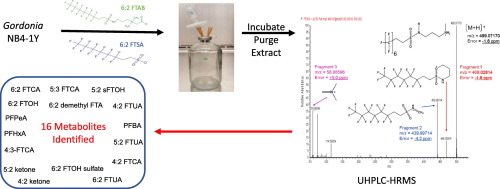Science of the Total Environment ( IF 8.2 ) Pub Date : 2018-08-03 , DOI: 10.1016/j.scitotenv.2018.08.012 Dayton M.J. Shaw , Gabriel Munoz , Eric M. Bottos , Sung Vo Duy , Sébastien Sauvé , Jinxia Liu , Jonathan D. Van Hamme

|
6:2 fluorotelomer sulfonamidoalkyl betaine (6:2 FTAB) is a major component of aqueous film-forming foams (AFFFs) used for firefighting and is frequently detected, along with one of its suspected transformation products, 6:2 fluorotelomer sulfonate (6:2 FTSA), in terrestrial and aquatic ecosystems impacted by AFFF usage. Biochemical processes underlying bacterial biodegradation of these compounds remain poorly understood due to a lack of pure culture studies. Here, we characterized the water-soluble and volatile breakdown products of 6:2 FTSA and 6:2 FTAB produced using Gordonia sp. strain NB4-1Y cultures over seven days under sulfur-limited conditions. After 168 h, 99.9% of 60 μM 6:2 FTSA was degraded into ten major breakdown products, with a mol% recovery of 88.2, while 70.4% of 60 μM 6:2 FTAB was degraded into ten major breakdown products, with a mol% recovery of 84.7. NB4-1Y uses two pathways for 6:2 FTSA metabolism, with 55 mol% of breakdown products assigned to a major pathway and <1.0 mol% assigned to a minor pathway. This work indicates that rapid transformation of 6:2 FTSA and 6:2 FTAB can be achieved under controlled conditions and improves the bacterial metabolism of these compounds.
中文翻译:

Gordonia sp。对6:2含氟端粒磺酰胺基烷基甜菜碱和6:2含氟端粒磺酸盐的降解和脱氟。硫限制条件下的菌株NB4-1Y
6:2含氟端粒磺酰胺基烷基甜菜碱(6:2 FTAB)是用于消防的水性成膜泡沫(AFFF)的主要成分,经常被发现以及其怀疑的转化产物之一6:2含氟端粒磺酸盐(6: 2 FTSA),受AFFF使用影响的陆地和水生生态系统。由于缺乏纯培养研究,对这些化合物细菌生物降解的生化过程知之甚少。这里,我们的特点的6水溶性和挥发性的分解产物:2 FTSA和6:使用2 FTAB产生大头sp。NB4-1Y菌株在硫限制条件下培养7天。168小时后,将99.9%的60μM6:2 FTSA降解为十种主要分解产物,摩尔%回收率为88.2,而70.4%的60μM6:2 FTAB被降解为十种主要分解产物,其中一摩尔回收率为84.7。NB4-1Y使用两种途径进行6:2 FTSA代谢,其中55 mol%的分解产物分配给主要途径,<1.0 mol%分配给次要途径。这项工作表明,在受控条件下可以实现6:2 FTSA和6:2 FTAB的快速转化,并改善了这些化合物的细菌代谢。































 京公网安备 11010802027423号
京公网安备 11010802027423号